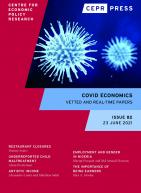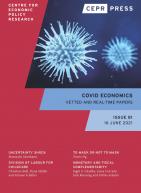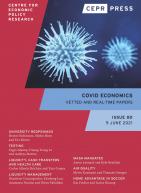
Using the full population of registered unemployed individuals in Sweden, we study the unequal labor market impact of Covid-19 depending on gender, wage, age, and country of birth. Also, having very detailed data on the occupation of the unemployed, we can study inequalities both across and within occupations. We find that two demographic factors are associated with higher unemployment in the pandemic: being young and being foreign-born. Gender, however, does not seem to play a big role in the Swedish context, likely due to both institutional factors and labor market structure, as well as policy measures such as not closing schools and day-care facilities. We also find a clear wage gradient with lower-paying jobs having higher unemployment risk. Our results confirm previous findings on the most vulnerable being hit the hardest, but at the same time emphasize the importance of country specific studies to understand the economic impacts of the pandemic.
Citation
Roine, J, S Strömberg and P Campa (2021), ‘Unemployment inequality in the pandemic: Evidence from Sweden‘, COVID Economics 83, CEPR Press, Paris & London. https://cepr.org/publications/covid-economics-issue-83#392514_392959_408763
Recent research on the U.S. stock market finds that the stocks of firms with high ESG (environmental, social, and corporate governance) ratings perform relatively well during crisis periods and thus serve as “rainy day assets” for investors. We assess this hypothesis in a global setting by assessing the relation between ESG and stock price performance during the COVID-19 crisis. In a sample of more than 6,000 stocks in 45 countries, we find little evidence that firms with higher ESG ratings had better stock market performance in the first quarter of 2020. The exception is North America, where stocks with higher ESG ratings have shown some degree of resilience during crises. Our findings indicate that the ability of socially responsible firms to deliver superior risk-adjusted stock market performance is still debatable and, at best, geography dependent.
Citation
Gianfrate, G, T Kievid and M Van Dijk (2021), ‘On the Resilience of ESG Stocks during COVID-19: Global Evidence‘, COVID Economics 83, CEPR Press, Paris & London. https://cepr.org/publications/covid-economics-issue-83#392514_392959_390794
We use hand-collected data to investigate the COVID-19 bailouts for all publicly listed US firms. The median tax rate is 4% for bailout firms and 16% for no-bailout firms. The bailouts are expensive when compared to past corporate income tax payments of the bailout firms. We compute the number of years a bailout recipient has to pay corporate income tax to generate as much tax revenue as it received in bailouts: 135.0 years for the Paycheck Protection Program and 267.9 years for the airline bailouts. We also document a dark side of the bailouts. For many firms, the bailouts appear to be a windfall. Numerous bailout recipients made risky financial decisions, so bailing them out might induce moral hazard. Moreover, lobbying expenditures positively predict the bailout likelihood and amount.
Citation
Smith, J and J Meier (2021), ‘The COVID-19 Bailouts‘, COVID Economics 83, CEPR Press, Paris & London. https://cepr.org/publications/covid-economics-issue-83#392514_392959_390796
There was a surge in the participation of retail investors in the stock market during the year 2020, with a large set of new investors starting to trade stocks on fintech platforms for the first time. This development could seem surprising, as the Covid-19 pandemic likely increased uncertainty and entailed negative wealth effects. In most canonical models of stock trading, at least one of these effects would imply a reduced demand for risky assets (such as stocks). This paper develops a model which incorporates both effects and maintains the assumption of weak form efficient markets. It shows that the observed surge of demand is best explained by there being investors whose trading is based on common sentiment analysis rather than fundamental analysis. Reduced opportunity costs of participation can help further. We provide arguments that both trends have increased over the past year. The paper also contributes to the REE literature by considering wealth effects and sentiment effects jointly in a stylized setting that has an analytical solution. It derives new predictions on the relationship between stock market participation and asset prices.
Citation
Tinn, K (2021), ‘Everyone is a stock trader now: retail investors and Covid-19‘, COVID Economics 83, CEPR Press, Paris & London. https://cepr.org/publications/covid-economics-issue-83#392514_392959_390795
We use a novel empirical approach to decompose the impact of different economic, demographic, and Covid factors (such as lockdowns, fear of the virus, and vaccination rate) on consumption spending and spending inequality on a week-by-week basis throughout the Covid-19 pandemic. This allows us to study how different demographic and economic groups were differentially affected by the pandemic while crucially controlling for other factors. We find that Hispanic and college-educated populations show particularly large and persistent falls in relative consumption. Spending inequality is persistently driven by political affiliation, age, education, and Covid factors. At a more disaggregated level of spending, political affiliation and Covid factors have a much stronger and more persistent impact on spending that is social-distancing-sensitive (SDS) such as travel and restaurant dining than non-SDS spending.
Citation
Garga, V, J Rohan and C Cotton (2021), ‘Consumption Spending and Inequality during the Covid-19 Pandemic‘, COVID Economics 83, CEPR Press, Paris & London. https://cepr.org/publications/covid-economics-issue-83#392514_392959_390793
New variants of the virus are spreading, which, together with seasonal effects, are estimated to be able to raise effective reproduction numbers by up to 90%. Meanwhile, many countries are rolling out vaccination programmes, but at varying speeds. Hence the race is on to beat the variants with the vaccines. Vaccination is very powerful at reducing virus transmission: fully vaccinating 20% of the population is estimated to have the same effect as closing down public transport and all-but-essential workplaces; fully vaccinating 50% of the population would have a larger effect than simultaneously applying all forms of containment policies in their most extreme form (closure of workplaces, public transport and schools, restrictions on travel and gatherings and stay-at-home requirements). For a typical OECD country, relaxing existing containment policies would be expected to raise GDP by about 4-5%. Quick vaccination would thus help limit the extent to which containment policies need to be escalated in future epidemic waves, providing huge welfare benefits both in terms of fewer infections and stronger economic activity.
Citation
Turner, D, B Égert, Y Guillemette and J Botev (2021), ‘The tortoise and the hare: The race between vaccine rollout and new COVID variants‘, COVID Economics 83, CEPR Press, Paris & London. https://cepr.org/publications/covid-economics-issue-83#392514_392959_390792
The containment of COVID-19 critically hinges on individuals’ behavior. We investigate how individuals react to variations in COVID-19 reporting. Using a survey, we elicit individuals’ perceived infection risk given various COVID-19 metrics (e.g., confirmed cases, reproduction rate, or case-fatality ratio). We proxy individuals’ risk perception with their willingness to pay for the participation in everyday life and amusements events. We find that participants react to different COVID-19 metrics with varying sensitivity. We observe a saturation of sensitivity for several measures at critical limits used in the political discussion, making our results highly relevant for policy makers in their efforts to direct individuals to adhere to hygienic etiquette and social distancing guidelines.
Citation
Warkulat, S, M Pelster, S Krull, R Ortmann and N Klocke (2021), ‘COVID-19 Reporting and Willingness to Pay for Leisure Activities‘, COVID Economics 83, CEPR Press, Paris & London. https://cepr.org/publications/covid-economics-issue-83#392514_392959_390791


Covid Economics - Issue 81

Covid Economics - Issue 80
- The impact of University reopenings on COVID-19 cases in Scotland
- Lives versus livelihoods during the COVID-19 pandemic: How testing softens the trade-off
- Liquidity constraints, cash transfers and the demand for health care in the Covid-19 pandemic
- Banks’ Liquidity Management During the COVID-19 Pandemic
- The Impact of Mask Mandates on the Trade-Off Between GDP and COVID-19 Mortality
- COVID-19 and Environment: An investigation of the COVID-19 pandemic effects of the air quality in Europe
- COVID-19, Home Advantage in Professional Soccer, and Betting Market Efficiency